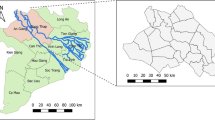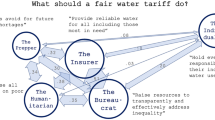Abstract
In this paper, we have proposed a behavioral DEA model to evaluate Chinese provincial carrying states. To introduce the behavioral DEA model, we take the individual decision maker’s preference into account, including fairness concern, reference dependence and loss aversion. By considering those decision preferences, the proposed models can help to make fair planning with accounting for decision maker’s utilities. Our proposed model provides the detailed technique to demonstrate the fairness concern, reference dependence and loss aversion quantificationally. An empirical study in evaluating Chinese provincial carrying states is used to demonstrate our methods. We also provide comparative analysis and correlation analysis to discuss the results and point out the managerial implications of this study.




Similar content being viewed by others
References
Andersen, P., & Petersen, N. C. (1993). A procedure for ranking efficient units in data envelopment analysis. Management Science, 39(10), 1261–1264.
Banker, R. D., Charnes, A., & Cooper, W. W. (1984). Some models for estimating technical and scale inefficiencies in data envelopment analysis. Management Science, 30(9), 1078–1092.
Charnes, A., Cooper, W. W., Golany, B., Seiford, L., & Stutz, J. (1985). Foundations of data envelopment analysis for Pareto–Koopmans efficient empirical production functions. Journal of Econometrics, 30(1–2), 91–107.
Charnes, A., Cooper, W. W., & Rhodes, E. (1978). Measuring the efficiency of decision making units. European Journal of Operational Research, 2(6), 429–444.
Doyle, J., & Green, R. (1994). Efficiency and cross-efficiency in DEA: Derivations, meanings and uses. Journal of the Operational Research Society, 45(5), 567–578.
Kahneman, D., & Tversky, A. (1979). Prospect theory: An analysis of decision under risk. Econometrica: Journal of the Econometric Society, 47, 263–291.
Li, Y., Yang, F., Liang, L., & Hua, Z. (2009). Allocating the fixed cost as a complement of other cost inputs: A DEA approach. European Journal of Operational Research, 197(1), 389–401.
Liang, L., Yang, F., Cook, W. D., & Zhu, J. (2006). DEA models for supply chain efficiency evaluation. Annals of Operations Research, 145(1), 35–49.
Tversky, A., & Kahneman, D. (1991). Loss aversion in riskless choice: A reference-dependent model. The Quarterly Journal of Economics, 106(4), 1039–1061.
Tversky, A., & Kahneman, D. (1992). Advances in prospect theory: Cumulative representation of uncertainty. Journal of Risk and Uncertainty, 5(4), 297–323.
Yang, F., Ang, S., Xia, Q., & Yang, C. (2012). Ranking DMUs by using interval DEA cross efficiency matrix with acceptability analysis. European Journal of Operational Research, 223(2), 483–488.
Yang, F., Wu, D. D., Liang, L., & O’Neill, L. (2011). Competition strategy and efficiency evaluation for decision making units with fixed-sum outputs. European Journal of Operational Research, 212(3), 560–569.
Acknowledgements
This research work has been supported by National Natural Science Foundation of China (Grant Nos. 71631006 and 71771071).
Author information
Authors and Affiliations
Corresponding author
Appendix
Appendix
Rights and permissions
About this article
Cite this article
Yang, D., Xia, Q. Behavioral DEA model in evaluating the regional carrying states in China. Ann Oper Res 268, 315–331 (2018). https://doi.org/10.1007/s10479-018-2785-3
Published:
Issue Date:
DOI: https://doi.org/10.1007/s10479-018-2785-3




